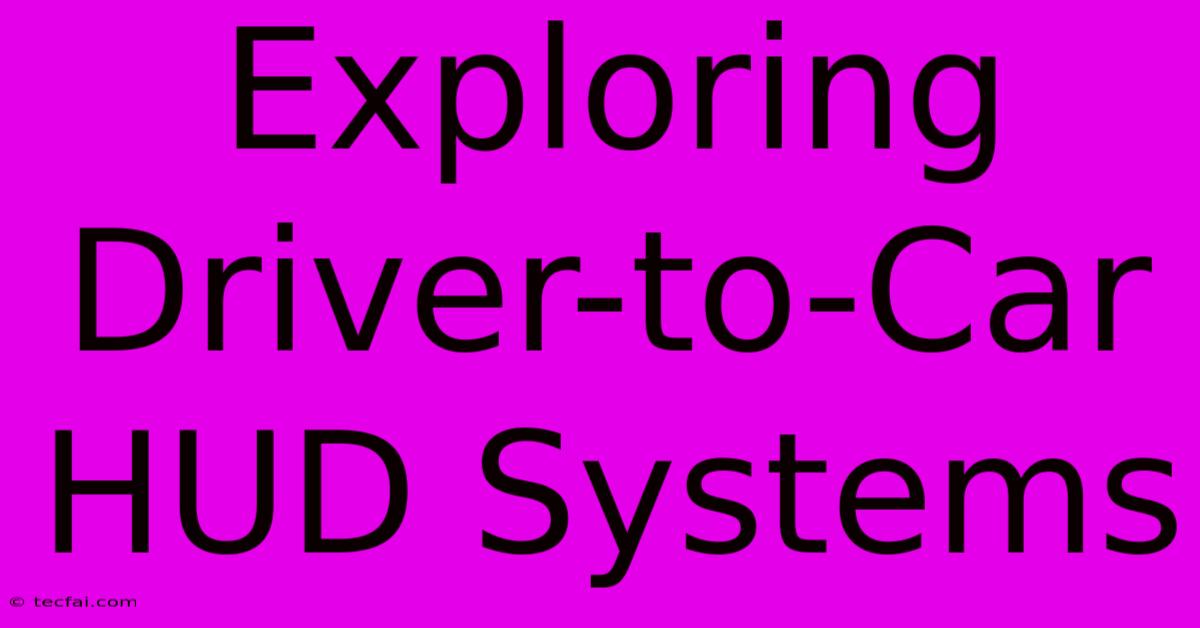Exploring Driver-to-Car HUD Systems

Discover more detailed and exciting information on our website. Click the link below to start your adventure: Visit Best Website tecfai.com. Don't miss out!
Table of Contents
Exploring Driver-to-Car HUD Systems: The Future of In-Car Information
Heads-Up Displays (HUDs) are rapidly evolving from a luxury feature in high-end vehicles to a potentially standard component in the automotive landscape. But what exactly are driver-to-car HUD systems, and what makes them so significant for the future of driving? This article explores the technology, benefits, and challenges associated with this innovative approach to in-car information delivery.
Understanding Driver-to-Car HUD Technology
Traditional HUDs project information onto the windshield, primarily focusing on navigation, speed, and engine data. Driver-to-car HUDs, however, represent a paradigm shift. They leverage advanced technologies to create a more interactive and integrated system, often incorporating features beyond simple data projection.
This typically involves:
-
Augmented Reality (AR) Integration: Overlaying digital information onto the real-world view, enhancing the driver's perception of their surroundings. This could include real-time navigation guidance projected directly onto the road, or warnings about potential hazards.
-
Gesture Control and Voice Recognition: Minimizing driver distraction by allowing control of HUD functions through intuitive gestures or voice commands. This allows for seamless interaction without taking hands off the wheel.
-
Advanced Driver-Assistance Systems (ADAS) Integration: Seamlessly integrating crucial data from ADAS features like lane departure warnings, adaptive cruise control, and blind-spot monitoring directly into the HUD's display.
-
Improved Display Quality and Brightness: Modern HUDs boast superior image quality and brightness, ensuring optimal visibility under various lighting conditions, even direct sunlight.
Benefits of Driver-to-Car HUD Systems
The advantages of driver-to-car HUDs extend beyond mere convenience; they address critical safety and user experience concerns:
-
Enhanced Safety: By keeping crucial information within the driver's direct line of sight, HUDs reduce the need to look away from the road, significantly minimizing distraction and improving reaction times.
-
Reduced Driver Fatigue: The ease of accessing vital information without diverting attention contributes to reduced driver fatigue, especially during long journeys.
-
Improved Situational Awareness: Features like AR overlays enhance the driver's awareness of their surroundings, particularly in challenging driving conditions.
-
Personalized User Experience: Customizable settings and preferences cater to individual driver needs and preferences, optimizing the in-car experience.
-
Seamless Integration: The integration of multiple systems, from navigation to ADAS, provides a holistic and streamlined in-car information ecosystem.
Challenges and Future Developments
While the potential of driver-to-car HUD systems is vast, several challenges remain:
-
Cost: The advanced technology involved can currently make these systems expensive to implement, limiting their availability to higher-end vehicles.
-
Calibration and Accuracy: Maintaining precise calibration and accuracy of the projected information is crucial to avoid misleading or confusing the driver.
-
Distraction Potential: While designed to reduce distraction, overly complex or cluttered HUD displays can have the opposite effect, demanding careful design considerations.
-
Environmental Factors: Weather conditions, such as heavy rain or snow, can affect the visibility of the projected information, requiring robust solutions to ensure consistent performance.
The future of driver-to-car HUD systems holds immense potential. We can anticipate further advancements in AR technology, more sophisticated integration with ADAS features, and a gradual decrease in cost, making them a more accessible feature across the automotive market. As these systems evolve, they are poised to redefine the driving experience, improving both safety and user satisfaction significantly. The shift from simply displaying information to actively enhancing the driver's interaction with their vehicle is already underway, promising a safer and more intuitive future of driving.

Thank you for visiting our website wich cover about Exploring Driver-to-Car HUD Systems. We hope the information provided has been useful to you. Feel free to contact us if you have any questions or need further assistance. See you next time and dont miss to bookmark.
Featured Posts
-
Bayern Wins Kim Stars Vs Psg
Nov 27, 2024
-
Arsenal Rout Artetas Landmark Comment
Nov 27, 2024
-
Abbotts Strong Scg Performance
Nov 27, 2024
-
Tariffs On Mexico Canada China Trades Uncertain Future
Nov 27, 2024
-
Vanderpump Rules Season 12 Confirmed
Nov 27, 2024
